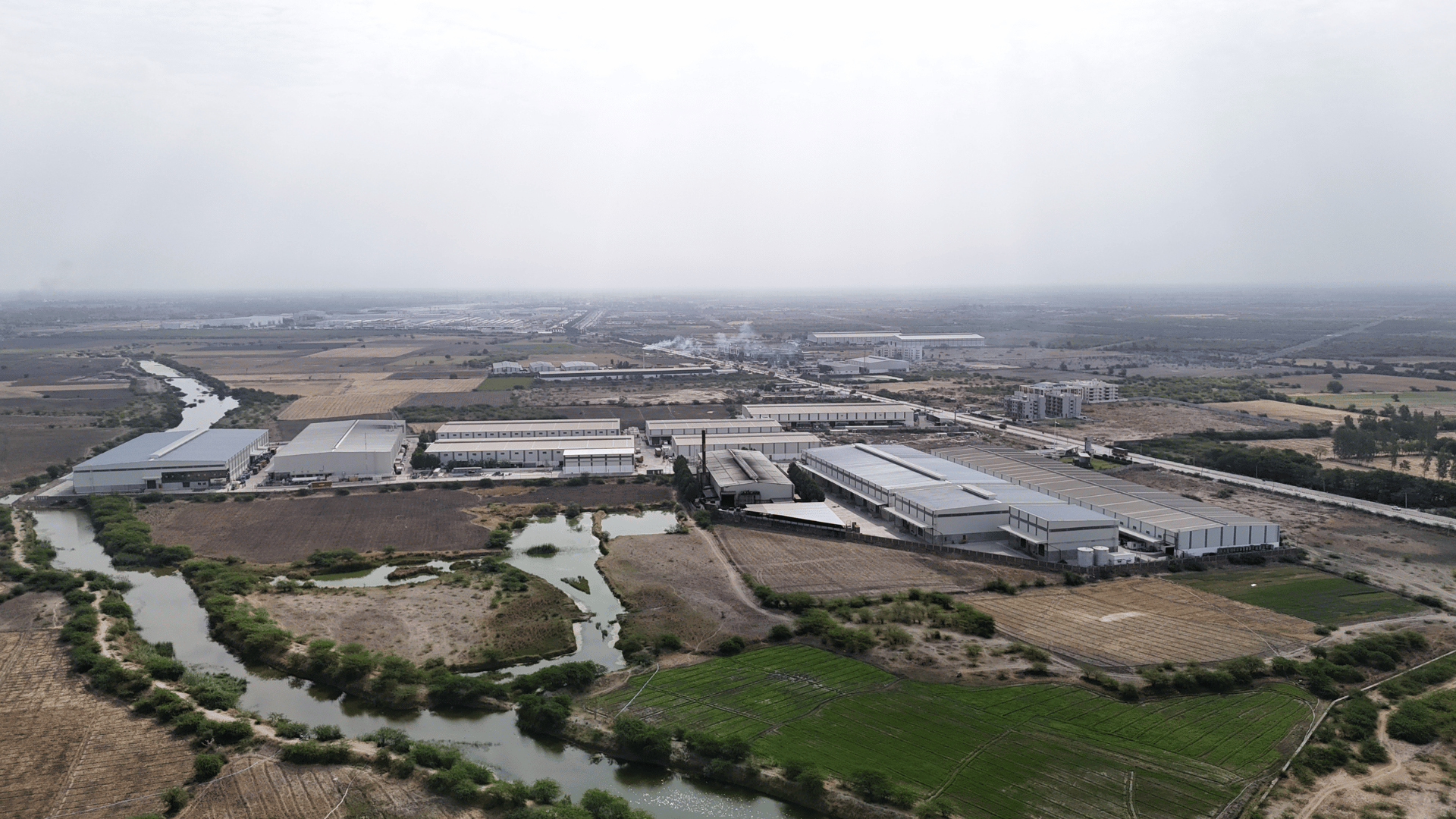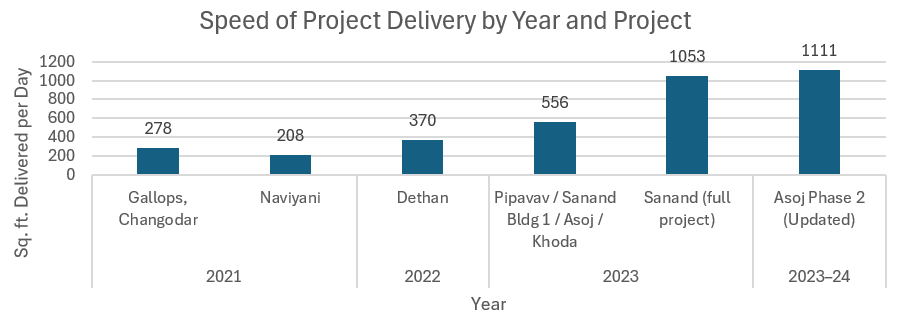Reducing Timeline of Facility Delivery in Industrial Real Estate

Executive Summary
In India’s fast-evolving industrial real estate landscape, timelines for delivering Grade A facilities have become a critical differentiator for occupiers to choose developers and industrial parks. Godwitt faced a recurring challenge: conventional in-situ construction methods took up to 12–16 months for a facility of 1 lakh sq. ft., impeding scalability and delaying occupier onboarding. Recognizing that speed to market was becoming just as important as location or cost, the team sought a transformative solution
To improve delivery timelines, we explored precast concrete as a primary construction method in a 1 lakh sq.ft. facility as a pilot project. After early trials and mixed results, the company partnered with and appointed PSP Projects to refine designs and processes for precast implementation at scale. A ~0.5 million square foot development in Sanand called Soko by Godwitt - Khoda, helped establish a standardised design and execution model.
What began as cautious piloting quickly evolved into a full-scale transition. By 2024, Godwitt slashed timelines to just 6 months while increasing productivity by over 5x (208 sq. ft./day to 1,111 sq. ft./day). This case study captures the journey from experimentation to a scalable model of in-house, factory-quality development, setting a new industry benchmark.
1. The Challenge
From inception till the end of 2020, Godwitt largely relied on conventional construction, a combination of pre-engineered steel buildings, in-situ reinforced concrete, and on-site fabrication. While this being the industry standard in India, this approach came with several inherent weaknesses:
- Typical delivery cycles: 12–16 months for a 1 lakh sq. ft. facility.
- High dependency on weather and manual labour; curing cycles were often extended during monsoons.
- Limited ability to execute multiple projects across diverse geographies concurrently.
At our projects, Soko by Godwitt-Detroj, Soko by Godwitt - Dethan, the challenges became tangible. In Soko by Godwitt-Detroj, over 23 inches of rain stalled site work for several weeks, while foundations lay waterlogged, steel fabrication slowed, and labour movement near-impossible. In Soko by Godwitt - Navyani, conventional methods delayed speculative builds that otherwise could have been leased sooner.
It was clear that the old methods could not deliver at the speed and reliability the next generation of industrial tenants demanded.
2. The Turning Point
Godwitt began exploring alternatives in the beginning of 2021. The first pilot project involving precast components took place at Gallops Industrial Park in Changodar, with Amneal Pharmaceuticals and Nykaa Cosmetics as tenants. Executed with our vendor partner B.N. Precast at that time.
While there were early signs of efficiency, we met with unforeseen issues. The interface between in-situ foundations and precast superstructures caused alignment problems and delays. We soon realised that precast wasn’t just a plug-and-play material upgrade, it required a full systems rethink.
The real turning point arrived with the discovery and engagement of PSP Projects, a precast specialist with a vertical production stack.
3. The Solution: Precast Adoption & Ecosystem Building
3.1 Pilot to Production: Changodar → Pipavav → Khoda → Asoj
Following the Changodar pilot, Godwitt scaled experiential learning through a sequence of geographically diverse projects:
- Soko by Godwitt - Pipavav: A full precast facility for Contrans Logistics (80,000 sq. ft.). Validated precast for port-adjacent builds up to 11 metres.
- Soko by Godwitt - Khoda: India’s first fully precast industrial park, built in collaboration with PSP. A 500,000+ sq. ft. development that served as a blueprint for modular scaling.
- Soko by Godwitt - Asoj: Entirely precast from foundation to roofing. Proved that precast could go beyond warehouses and into complex industrial shells.
3.2 Strategic Partnership: PSP Projects → 9–10 Lakh Sq. ft. Pipeline
The collaboration with PSP Projects evolved into a strategic asset. Co-located production facilities enabled JIT (Just-In-Time) delivery. PSP’s know-how reduced rookie errors. Godwitt scaled the model fast, delivering nearly 9–10 Lakh sq. ft. using this method by 2024.
3.3 Design Innovation: Switching to RCC Precast from Steel
Design shifts made scaling truly possible:
- Steel columns (prone to fabrication delays) were replaced with precast RCC columns.
- Modular joint details were standardized across sites.
- Foundation designs re-engineered for precast specifications.
3.4 Spec Upgrades: Panels, Light Monitors & Precast Roads
Improvements extended to finishes and utility provisions:
- 13mm XLPE sandwich panels replaced older XLPE + sheet metal combos.
- Outcome: faster installation time, better insulation, improved waterproofing.
- Light monitors from roofs were moved to vertical cladding, reducing leakage risk and speeding roofing cycles.
- Precast access and spine roads were implemented, optimizing site handovers and utility sequencing.
3.5 Process Resilience: Weather-Proofing via Offsite Production
Traditional construction suffered severely from weather exposure. Precast shifted 70%+ of building work to weather-independent conditions.
The Soko by Godwitt - Detroj incident illustrated this: when work was halted onsite by rain, precast panels continued production in offsite yards. As the site cleared, plug-and-assemble resumed, regaining lost time.
4. In-House Precast: Scaling Control & Speed
The final layer of transformation was control.
Transporting precast elements from Ahmedabad to South Gujarat (e.g., Panoli, Nana Borsara) brought unexpected logistics costs and delays. During India’s infrastructure boom, even scheduling trucks became challenging.
The solution: Mobile, on-site precast units.
At the Soko by Godwitt - Nana Borsara project, in Panoli, Godwitt set up and operated an on-site precast facility, casting structural elements in parallel to foundation and access road work. Benefits:
- Daily construction productivity and progress accelerated to ~ 1,111 sq. ft. per day.
- Multiple facilities erected simultaneously without transport dependencies.
- Real-time QC for each pour and element.
At Soko by Godwitt - Nana Borsara, a mobile precast plant gave full autonomy. Casting, curing, and stacking occurred within the compound, cutting transport emissions, enabling flexibility, and reducing cost/sq. ft. meaningfully.
This pivotal move allowed Godwitt to achieve:
- Repeatable speed without compromising quality.
- Scalable moulds that could be ported to future sites.
- Reduced site manpower and risk exposure.
5. Impact & Results
5.1 Quantitative Outcomes
- Productivity jumped from ~ 208 Sq.Ft. / Day(2020) to ~ 1,111 Sq.Ft. / Day (2024).
- Average delivery timelines dropped from 12–16 months to just 6 months.
- Cost/sq. ft. reduced due to economies of scale.

.png)
5.2 Quality & Experience
- Occupier go-live certainty improved, facilities delivered on time enabled early commissioning.
- Engineering standardization improved cross-site reproducibility.
- Internal teams executed more with less, better morale, and fewer firefighting.
5.3 Sustainability
Precast enabled greener construction:
- Fly ash, GGBS, and copper slag used to replace cement and aggregates.
- On-site material movement cut dramatically.
- Site pollution controls easier to implement with reduced wet work.
6. Key Learnings & Future Outlook
6.1 What Worked
- Start small: Early pilots (even with flaws) built resilience and know-how.
- Right partner: PSP Projects elevated the precast effort into an ecosystem.
- Ownership matters: In-house precast gave Godwitt control over time, cost, and quality.
6.2 What Didn’t
- Early foundation misalignment slowed progress; precast requires ground-up design alignment.
- Logistics from Ahmedabad to remote sites increased costs, emphasized the need for mobile setups.
Conclusion
Godwitt’s journey, from 12–16 months builds to completing facilities in under 6 months, wasn’t just about swapping steel for concrete. It was about rethinking the process, ownership, and resilience. From the Soko by Godwitt - Detroj rains to the Soko by Godwitt - Nana Borsara precinct, each test reinforced the need for methods that combine speed with control and sustainability. Godwitt proved that reduced project timelines don’t have to mean cutting corners. With precast systems, modular assembly, and an owned supply chain, the firm built faster, greener, and better. As industrial real estate in India scales to meet global demand, this approach provides a proven, replicable model where consistency, speed, and tenant confidence go hand in hand.

Why to sign up for a newsletter
Open













